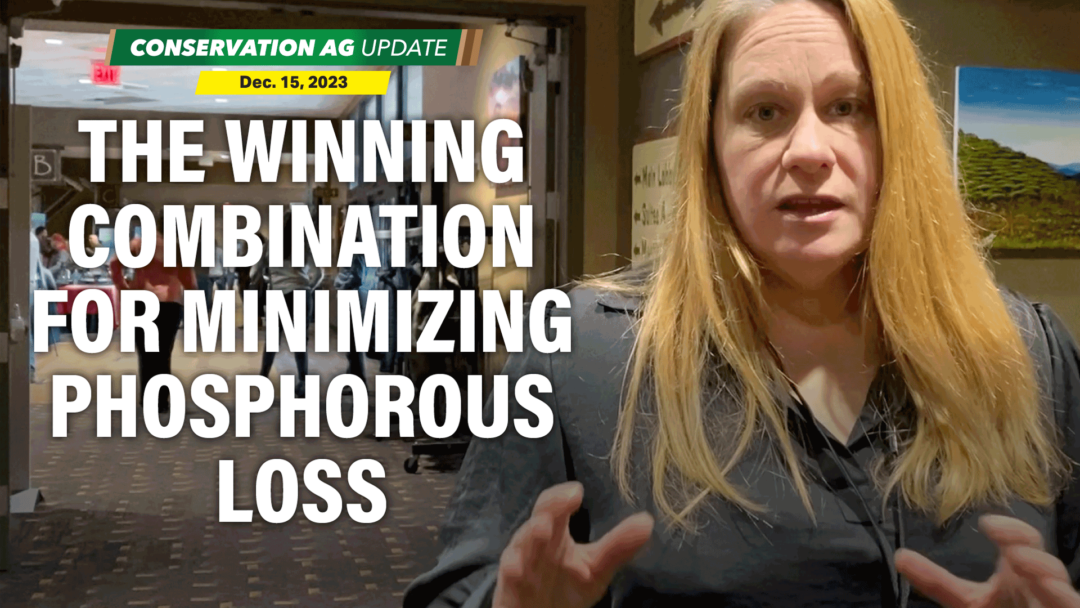On this episode of Conservation Ag Update, brought to you by CultivAce, the winning no-till combination for minimizing phosphorous loss is revealed at the Water and Soil Health Conference in Wisconsin Dells. Plus, associate editor Mackane Vogel checks in with some cover crop tips from the Soil Management Summit in Alexandria, Minn.
Also in the episode, Hatton, Mo., no-tiller Luke Linnenbringer shares the secret behind his 1-pass system for soybeans, Star of the West Milling Co. helps secure big paychecks for no-tillers, Susterre CEO Michael Cully showcases ultra high-pressure water jets for cutting through residue and a major conservation award is handed out at the Big Soil Health Event in Cedar Falls, Iowa.
This episode of Conservation Ag Update is brought to you by CultivAce.
CultivAce is a West Coast manufacturer and distributor of a comprehensive line of foliar and starter fertilizers. CultivAce offers innovative solutions that drive agricultural crop yields and cultivate profitableoutcomes.
With a relentless focus on delivering the highest quality foliar and starter fertilizers, we are committed to empowering growers with the tools they need to achieve remarkable results. CultivAce is built on two fundamental principles: products must be the highest quality, and they must make the grower money. If a product doesn’t meet these standards, CultivAce doesn’t manufacture it.
For more information go to CultivAcegrowth.com.
TRANSCRIPT
Jump to a section or scroll for the full episode...
- The Winning Combination for Minimizing Phosphorous Loss
- Farmer Feature: Luke Linnenbringer, Hatton, Mo.
- Cover Crop Connection: Understanding the Role of Cover Crop Root Exudates
- Regenerative Ag Becoming 'Expectation' for Food Companies
- Ahead of the Curve: Susterre’s Water Jets Boost Yields by 12%
- Video of the Week: Steinlage receives Iowa Leopold Conservation Award
The Winning Combination for Minimizing Phosphorous Loss
The Water and Soil Health Conference took place in Wisconsin Dells last week. Merrin Macrae from the University of Waterloo in Canada delivered the keynote presentation on phosphorous loss in cold regions. Road warrior Michaela Paukner caught up with her for a key no-till takeaway and the winning combo when it comes to minimizing loss.
“The best thing that people can do is accompany no-till with a subsurface band or subsurface placement at the time of seeding. That is going to be the best thing to minimize phosphorous losses. But in some landscapes, especially if you have a lot of tile drainage in clays and preferential flow between the surface and those clays, you might be better off with a rotational conservation-till just to break up that stratification rather than being a full no-till and leaving it on the surface, just because of that danger.
Macrae says the planter is the best tool to use for subsurface placement to minimize soil disturbance.
Farmer Feature: Luke Linnenbringer, Hatton, Mo.
Today’s Farmer Feature takes us to Hatton, Mo., where Luke Linnenbringer was struggling with degraded soils and stagnant yields until he made the switch from conventional tillage to no-till in 2012.
He plants cover crops on all his acres, either drilling or broadcasting 1 bushel of cereal rye per acre after fall harvest. And he built his own roller attachments for his John Deere 7340 planter to flatten cereal rye at planting. The rollers are 5 feet wide. He built them using 8-inch tube steel walls and added bearings and springs to finish the attachment. The rollers are a big part of his 2-pass system for soybeans.
“These weigh about 5-600 pounds apiece, and the weight of them lays the crop down. I’m just using the rolled rye as a mulch. I use chemicals to terminate after, but the roller provides me a mulch on the ground that I work with. I have tanks on here that I use for 2-by-2 fertilizer and starter, or when I’m planting beans, I use these tanks for spray, and I spray with the planter as well. So, I’ll roll, plant, spray and lay down the fertilizer in one pass, and I’ve had conventional beans that I haven’t had to go back to until I harvested them. So, it’s a 2-pass system, planting and harvesting.”
Luke lets the rye grow well into spring. He says he doesn’t have any problems rolling the rye when it’s really heavy but does have some problems when it’s light.
Understanding the Role of Cover Crop Root Exudates
Good morning, from Alexandria, Minn., Mackane Vogel here, with this week’s cover crop connection. I’m here at the Soil Management Summit and this morning we are going through some live demonstrations. Why don’t we check in with Anna Cates of University of Minnesota Extension for a live cover crop demonstration.
“So as the plant pulls in carbon from the atmosphere, it’s building this biomass above ground — the shoots — it’s building those roots below ground and then it’s also sloughing off a lot of carbon in the form of exudates. So root exudates are what we call the kind of excess carbon that the plant gives up and that microbes take up to live on the plant. So, microbes like to live right on the surface — those roots — it’s like living next to a soup kitchen or something like that. They can just get as much food as they want, whenever they want to. The rate of nutrient cycling on the surface of the root can be four or five times higher than in the rest of the soil. That is because the microbes are there, they have ready access to food, and so they are able to do the things like transform an organic nitrogen into plant available nitrogen or plant available phosphorus and other nutrients so that the plant can take those up. So, what are root exudates, what are they made of? They are mostly just sugar — just carbohydrates — 85-90% sugar and carbohydrates. And so, for the microbe, it’s like your kids eating mac n cheese every single day. They are psyched, they are happy, they are moving along. The microbes like that stuff. The other part of it is organic acids and that can actually affect the structure in the soil. This organic acid can leach into the soil and liberate organic matter that was otherwise bound up with the clay particles. So you’ve got these two elements of the root exudates that help to speed up nutrient cycling — the one is just feeding microbes and keeping that population happy and the other is liberating some organic matter from the soil.
Lots of good stuff going on this week at the Soil Management Summit in Alexandria, Minn. Make sure you stay tuned in the coming weeks for more content.
Regenerative Ag Becoming 'Expectation' for Food Companies
A growing number of major food companies are teaming up with conservation-minded farmers. That’s where Star of the West Milling Company comes in. The Frankenmuth, Mich.,-based company is connecting no-tillers to some of those major food companies, and as sustainability director Lisa Woodke tells us, they helped farmers secure big money from a company called Airly Crackers.
“Airly is a division of Post. They came to us and said they wanted to work with farmers who have carbon negative wheat. We had to work through what that looked like doing an LCA on the farm and on our mill. All the growers that qualified are no-till, had added covers in the last 1-5 years, some use non-synthetic fertilizer, all of them track it. Some have solar panels, etc. Take all of that into account and we were able to certify that the fields were less than 20 CO2 equivalent per bushel, so negative 20 or better for all of the wheat that came from those growers that went into those Airly crackers.
The Airly brand is now carried at several hundred Wal-Mart locations. She says it’s the highest payment Star of the West has ever gotten for growers, but she’s optimistic it could soon become the norm.
Ahead of the Curve: Susterre’s Water Jets Boost Yields by 12%
Over 50 ag tech companies meanwhile gather inside the Innovation Hub to showcase cutting-edge technologies at the Nebraska Ag Expo. That’s where we find Susterre CEO Michael Cully. He gives us a rundown on his company’s use of ultra-high pressure water jets to cut through residue in no-till operations.
“Our product is a retrofit row unit that we can install on any existing planter. It consists of 2 parts, a ski part that presses down the residue on the field, and the jet that pumps water at 60,000 pounds per square inch. We’ve designed the product so it cuts through any amount of residue without having a hairpinning of residue, and without applying additional downforce onto the field. Our side-by-side testing has shown that we can produce 6-12% yield increases in most residue situations. And our goal is to keep regenerative farmers in the practice of no-till and the use of cover crops for more seasons.”
Cully says the product pays for itself within two planting seasons. He’ll have more information at the National No-Tillage Conference next month in Indianapolis. Head to NoTillConference.com to register.
Video of the Week: Steinlage receives Iowa Leopold Conservation Award
No-Till Farmer 2023 Conservation Ag Operator Fellow Loran Steinlage is formally presented with the 2023 Iowa Leopold Conservation Award. The prestigious honor recognizes farmers, ranchers and forestland owners who inspire others with their dedication to conservation practices. Thanks to Loran for all his insights over the past year and sharing his learning experiences with our audience.
Have an interesting photo or video from your farm? Or a story you’d like us to feature on the broadcast? Send me an email at Nnewman@lesspub.com.
And that will wrap things up this edition of Conservation Ag Update. Until next time, for more stories visit no-tillfarmer.com, striptillfarmer.com and covercropstrategies.com. Thanks for stopping by. Have a great day!









Post a comment
Report Abusive Comment